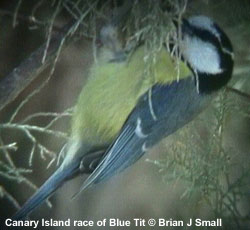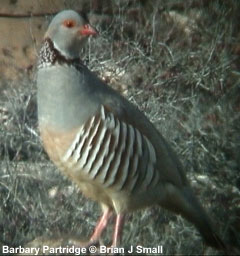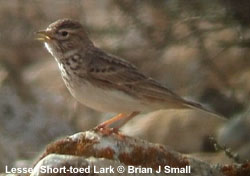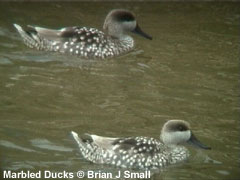
THE BIRDS OF FUERTEVENTURA - the chat, the bustard, the courser and the sandgrouse (continued...)
Text and video grabs by Brian J Small
Comments on other species and other sites
 There are still Marbled Ducks and Ruddy Shelducks on Fuerteventura, at Los Molinos, but it appears that the numbers are declining. I found four Marbled Ducks, with the head-bobbing display observed, and a maximum of five Ruddy Shelduck, but I suspect the numbers were augmented by the birds from Barranco de la Torre.
There are still Marbled Ducks and Ruddy Shelducks on Fuerteventura, at Los Molinos, but it appears that the numbers are declining. I found four Marbled Ducks, with the head-bobbing display observed, and a maximum of five Ruddy Shelduck, but I suspect the numbers were augmented by the birds from Barranco de la Torre.
Berthelot’s Pipits and Trumpeter Finches were abundant everywhere in Jan/Feb 2001, with the latter species clearly having had a very good breeding season (flocks of over 150 were noted at several sites). The best views of Trumpeter Finch were had on the cliffs north of El Castillo, where feeding of the Barbary Ground Squirrels had tamed the finches somewhat, and they came to c.2m at times.
 The eastern Canary Island race of Blue Tit, degener, is well worth a look – considering its treatment as a possible full species in some quarters, and the best site is the Betancuria/Vega de Rio Palmas area. At Betancuria they occur and sing openly in the town, especially around the café near the church – the ‘Guide’ also reports that they may be seen at La Oliva, but despite searching we couldn’t locate any . They are very smart, resembling the NW African race, and their voice is remarkably different to that of the Blue Tits from Europe.
The eastern Canary Island race of Blue Tit, degener, is well worth a look – considering its treatment as a possible full species in some quarters, and the best site is the Betancuria/Vega de Rio Palmas area. At Betancuria they occur and sing openly in the town, especially around the café near the church – the ‘Guide’ also reports that they may be seen at La Oliva, but despite searching we couldn’t locate any . They are very smart, resembling the NW African race, and their voice is remarkably different to that of the Blue Tits from Europe.
Plain Swift is described as resident, but scarce on the eastern islands. I found on both Lanzarote and on Fuerteventura that there is a probability that it is not resident, and that it may be absent for a short spell. In February 1999, on Lanzarote, they were absent until mid month, then arrived in small numbers (seen flying in off the sea) and subsequently seen uncommonly throughout the island. This pattern was repeated on Fuerteventura in 2001, when all swifts were absent until their arrival in early February, then could be found scarcely along some barrancos, but most notably at Los Molinos. Obviously, care in their identification is needed, and this is further increased by the knowledge that both Pallid and Common Swifts arrive at the same time – with Pallid the most common.
 Other more common species, will be ‘bumped into’ anywhere: Barbary Partridge was seen well at Barranco de la Torre and Las Penitas – is very much more common on Fuerteventura than Lanzarote; Lesser Short-toed Larks are abundant in the right areas, and apart from singing birds huge flocks form and sweep across the plains (the biggest flock was c.600); Egyptian Vultures cover large areas and are seen occasionally – we noted them at Pozo Negro (a regular pair that sometimes sit on the cliffs and hills north of the village), in the mountains around Betancuria, and the only immature was from the main road that crosses the Malpais Grande; Barbary Falcon also covers large areas, in 2001 we saw a large falcon in the hills east of La Lajita which was probably this species, they had previously been noted at this site.
Other more common species, will be ‘bumped into’ anywhere: Barbary Partridge was seen well at Barranco de la Torre and Las Penitas – is very much more common on Fuerteventura than Lanzarote; Lesser Short-toed Larks are abundant in the right areas, and apart from singing birds huge flocks form and sweep across the plains (the biggest flock was c.600); Egyptian Vultures cover large areas and are seen occasionally – we noted them at Pozo Negro (a regular pair that sometimes sit on the cliffs and hills north of the village), in the mountains around Betancuria, and the only immature was from the main road that crosses the Malpais Grande; Barbary Falcon also covers large areas, in 2001 we saw a large falcon in the hills east of La Lajita which was probably this species, they had previously been noted at this site.
 In reality, due to the extremely poor coverage, anything might turn up, within reason. In Jan/Feb 2001, I found 77 species, with the highlights being: an adult Spotted Sandpiper and Common Gull at Salinas del Carmen; there was a flock of eight Ring Ouzels of the race alpestris at Vega de Rio Palmas; a Fieldfare, Common Stonechat and Chaffinch at Caleta des Fustes (another Chaffinch was noted at the ‘woods’ at Costa Calma); three Little Shearwaters were seen from El Castillo in strong NE winds on 30th January; a juvenile Booted Eagle caused a bit of disturbance at Los Molinos on 2nd February.
In reality, due to the extremely poor coverage, anything might turn up, within reason. In Jan/Feb 2001, I found 77 species, with the highlights being: an adult Spotted Sandpiper and Common Gull at Salinas del Carmen; there was a flock of eight Ring Ouzels of the race alpestris at Vega de Rio Palmas; a Fieldfare, Common Stonechat and Chaffinch at Caleta des Fustes (another Chaffinch was noted at the ‘woods’ at Costa Calma); three Little Shearwaters were seen from El Castillo in strong NE winds on 30th January; a juvenile Booted Eagle caused a bit of disturbance at Los Molinos on 2nd February.
A last word on the birds, from a gull freak: anyone wanting to study the local Yellow-legged Gulls will obviously see them very commonly, but the best gathering is at the dump on the north side of Puerto del Rosario. An article on the race (presumed to be atlantis) will appear in the near future on Surfbirds.

Brian Small
March 2001